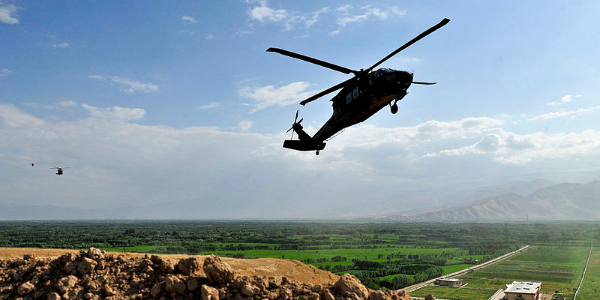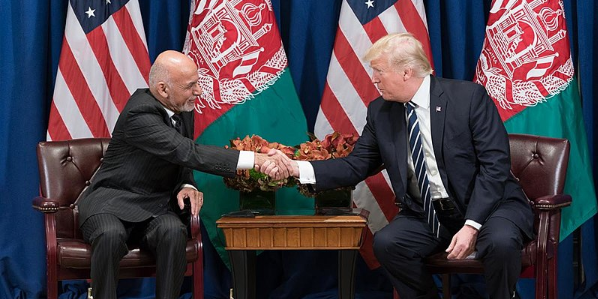
On August 21st, US President Donald Trump outlined his long awaited strategy for ending conflict in Afghanistan. Sayed Jalal Shajjan questions the civilian cost of this approach, and whether Afghanistan will ever find peace.
My life, like most people of my generation in Afghanistan, started in a home away from home – mostly in refugee camps inside and outside of the country. One of the things I remember since my childhood days is being told “soon the fighting will be over, and we will return to our home”. To live a life without being caught in the midst of a battle was a dream for everyone in the 1980s and 1990s. In Afghanistan today it is sadly to say, still a dream to live in peace without fear of violence.
To see some of the Afghan diaspora who are brought up or living in the west, and the current administration applauding the US President’s New Strategy for Afghanistan on Twitter, makes one wonder if they know how it feels to be bombed, or just by sheer luck miss a suicide bombing? The US President Donald Trump’s new strategy does not indicate that the war will be over soon, rather it says the “the heaviest burden will continue to be borne by the good people of Afghanistan and their courageous armed forces”. One needs to ask how long the people of Afghanistan will be able to endure such hefty prices?
The people of Afghanistan have suffered a lot in the past 40 years. During the 1990s civil war people lived under constant fear of where the next rocket might land. The Taliban era was relatively peaceful but not for all. It was about where one was living since areas under Taliban control were peaceful but not the northern parts of Afghanistan, where a severe resistance fight denied the Taliban full control of Afghanistan. Following the US-led invasion of Afghanistan after September 9/11 in 2001, most people were very hopeful that the US would bring freedom and peace, but with development and democracy it also brought more misery, more deaths and more violence, and suicide bombings. While during the civil war people could hide in basements, how would someone escape a suicide bombing, drone strike, or aerial bombardment? The fight has become more perilous and intensified – it has taken more innocent lives than ever before.

Helicopters fly over Samangan Province, Afghanistan. Image credit: US Army, Flickr CC BY 2.0
The US fight post 9/11 is now 16 years old, and as President Trump announces his new strategy to fight Taliban, a curious mind bears the question of how a strategy without a time frame would work? How a strategy which aims at killing terrorists and criminals would ensure no civilian is harmed? Will his harsh rhetoric on Pakistan result in action?
It is evident that a war cannot be won with a timeframe in mind. This is where this current strategy has differed from other strategies in the past 16 years. To have a timetable to win a war has been an illusion, and it hasn’t worked, and it will not work especially in a country like Afghanistan. The geographical location and mountainous terrains give the insurgents the upper hand to stretch the war as long as they want. What this strategy has done is to deny insurgents any hope of living a period of life in stasis and to re-emerge once forces withdraw. With a schedule in mind, the insurgents could easily remain passive until the deadline was over and the drawdown is complete. This is evident from the situation in Iraq when the US military withdrew in 2011. However, we need to ask at what cost? And is there a military solution to the ongoing war in Afghanistan?
What the new US strategy in Afghanistan has done is to ignore the harm it will inflict on civilians. Recently it was reported that in one incident almost 20 civilians were killed in a US-Afghan joint forces aerial attack in Afghanistan. There is no mechanism in play to protect civilians and decrease the civilian casualties. We have seen in the past the Taliban have used the civilians as shields. How then can the military personnel ensure to keep the safety of the civilian a priority? If the US victory will be limited to only “attacking enemies, obliterating ISIS, crushing al-Qaeda, preventing the Taliban from taking over Afghanistan” how will the future for Afghan people look? There has been a spike in the US military bombing in Afghanistan since President Trump announced his new strategy for Afghanistan. The US army dropped 555 bombs in August in Afghanistan, their targets were what the US President called “criminals and terrorists”. It was recently announced in a report by the Special Inspector General for Afghanistan Reconstruction, that the Taliban control almost 40% of the territory which homes around 3 million people. If bombing of such intensity continues, on the one hand, it will add up to the number of internally displaced people which is already at its highest and on the other hand it will also increase the number of Taliban sympathisers.


Afghanistan President Ashraf Ghani shakes US President Donald Trump’s hand at the United Nations General Assembly. Image credit: The White House
Announcing his administration new strategy the US President Donal Trump said that 20 U.S.-designated foreign terrorist organisations are active in Pakistan and Afghanistan. Curiously, the Taliban does not appear to be in the list of US-designated Terrorist groups. Regarding the existence of ISIS, Afghanistan former head of National Directorate of Security Amrullah Saleh said that there is no evidence to show that ISIS is active in Afghanistan and that it is all a “psychological warfare”. Regarding the activities of Al-Qaeda, there is the question of whether the Taliban would allow the group to operate from its territory or not. If we glance through to the list of US-designated foreign terror organisations, almost 6 out of 20 are located in Pakistan.
The US President has claimed the new strategy is a change in approach – especially towards relations with Pakistan. How big of a difference will this make? Indeed, what is clear is that President Trump’s harsh rhetoric and his willingness to call out Pakistan’s approach in dealing with terrorist groups was unprecedented, it certainly suggests that the US government is ready to take a tougher stance to compel Pakistan in changing its policy towards terrorist organisations. How far is he willing to go? If President Trump succeeds in working with Pakistan against the terrorist organisations jointly, hopefully, Afghanistan will see a brighter day, if not, nothing will change in the region.
This article gives the views of the authors, and not the position of the South Asia @ LSE blog, nor of the London School of Economics. Please read our comments policy before posting.
About the Author
 Sayed Jalal Shajjan is a development practitioner based in Kabul focusing on social and economic development, migration, peace, and terrorism. He holds an MSc degree in Anthropology and Development from the London School of Economics and Political Science and can be followed on twitter @jsaeedsh.
Sayed Jalal Shajjan is a development practitioner based in Kabul focusing on social and economic development, migration, peace, and terrorism. He holds an MSc degree in Anthropology and Development from the London School of Economics and Political Science and can be followed on twitter @jsaeedsh.








So, to summarize – America should destroy all of Afghanistan’s neighbors, and then everyone in Afghanistan will be living in utopia. There is an old proverb – only a fool thinks that one Qalet gets stronger by the destruction of a neighbor’s Qelat. But, then again, the frustrated and guilty always want to think it is someone else’s fault for their problems.